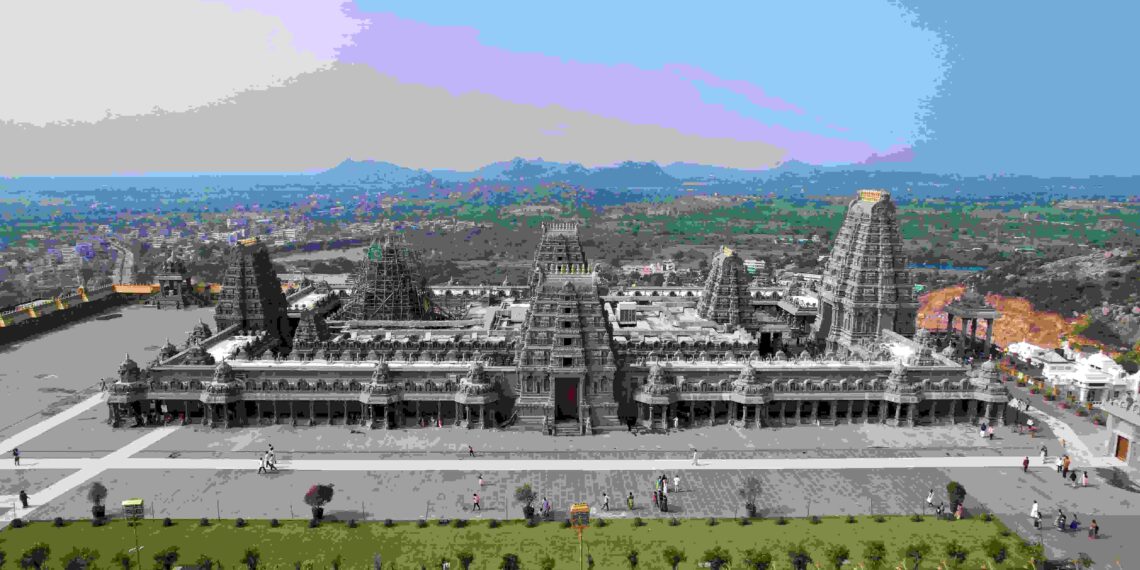The Yadagirigutta Narasimha Temple in Yadadri, Telengana, dedicated to Lord Narasimha, the lion-man avatar of Lord Vishnu, is one of the famous Narsimha Temple in India. Set on a rocky hill in Yadadri Bhuvanagiri district, its cave sanctum, stone carvings, and holy presence draw devotees and pilgrims from all over India.
Mythological Importance
The Yadagirigutta Narasimha Temple carries old legends. One story tells of sage Yadarishi, who prayed on this hill, seeking to have the darshan of Vishnu’s fierce Narasimha form. The Lord appeared in a cave, showing five forms: Jwala, Gandabherunda, Yogananda, Ugra, and Lakshmi Narasimha, carved from black stone. Another tale says Lord Hanuman visited here during the Ramayana, worshipping Lord Narasimha. Local belief holds that the hill’s caves have divine power, granting courage and protection. This makes the temple a key Narasimha shrine, tied to Vishnu’s protective grace.
Historical Overview
The temple began in the 11th century, under the Chalukya dynasty, though some say worship started earlier. Yadadri, 60 km from Hyderabad, was a holy spot, as per old records. A stone writing from 1050 CE near the hill marks a sacred cave, but the temple grew with Chalukya kings. In the 13th century, Kakatiya rulers added halls, as carvings show. The 1600s saw local chiefs build stone steps, making it a busy pilgrimage place.
In the 1800s, Hyderabad’s Nizams kept it safe, and prayers continued, Bhuvanagiri logs note. After 1947, Telangana’s leaders took over, and the Endowments Department now runs it. From 2016 to 2020, major repairs added new halls while keeping the old cave sanctum. Telugu songs by saints like Annamacharya, who sang of Vishnu, carried its name far. Today, it stands as a sign of strong faith, calling thousands to Yadadri’s hill.
Temple Structure and Design
The Yadagirigutta Narasimha Temple, covering 3 acres, blends Dravidian and Chalukya styles, rooted in the hill’s rugged charm. The gopuram, rebuilt in 2018, rises high with stone carvings of Narasimha’s roar, Vishnu with his conch, and sages praying, painted in cream and red. A stone door with lotus patterns leads to the cave sanctum, where the Narasimha idol, 2 feet tall, stands under a plain vimana, its stepped roof showing purity. The sanctum’s rock walls, worn by time, hold faint Chalukya etchings of Narasimha’s fight with Hiranyakashipu, lit by oil lamps.
Small shrines for Lakshmi, Hanuman, and Garuda are scattered on the hill, carved from local granite with open stone covers. The Lakshmi shrine, from 1200 CE, shows her with lotuses, granting wealth. The Hanuman shrine, by the steps, depicts him kneeling with a mace, carved in devotion. The Garuda shrine, facing Narasimha, shows the eagle mount with wings folded, calling for grace. These shrines, though small, join the temple’s worship, offering paths to faith.
Perched on Yadagirigutta hill, the temple is reached by 400 stone steps, worn by pilgrims over centuries. The steps pass small caves with old Narasimha carvings, some hidden in rocks, others open to the sky. The hilltop courtyard, paved with rough granite, feels holy, shaded by neem and peepal trees. A stone tank, fed by a hill spring, is used for ritual baths, its edges carved with fish shapes, a Chalukya touch. The temple’s low walls, made of plain stone, have niches for minor deities like Naga figures, said to guard the grounds.
Carvings on pillars and walls tell Narasimha’s stories—his battle, his calm Yogananda form, and his bond with Lakshmi—etched to guide devotees. The 2018 repairs added strong paths but kept the hill’s wild, sacred feel, making it a quiet place for prayer.
Rituals and Festivals
The temple holds festivals in it’s full capacity. Brahmotsavam, in February or March, is the biggest, honoring Narasimha with Kalyanotsavam (wedding ritual) and chariot procession. Maha Sudarshana Homam in April has fire rituals for safety. Deepavali in October or November sees lamp-lighting by the caves.
Daily worship includes Suprabhata Seva (morning prayers), Archana (offerings), and Deeparadhana (lamp ritual). Services like Abhishekam and Narasimha Homam can be booked at the temple office. A prasad stall gives free jaggery sweets to devotees. Tulasi Archana, offering basil leaves on Tuesdays, is for peace and strength.
Information for Travelers
Hours and Entry: Open daily, 4:00 AM to 1:00 PM, then 3:00 PM to 9:00 PM. Entry is free, but rituals cost 100-500 rupees.
Clothing: Wear modest clothes covering shoulders and knees. Men doing rituals wear dhotis, often bare-chested, as custom.
How to Get There:
Air: Hyderabad’s Rajiv Gandhi International Airport, 80 km away, is nearest. Taxis take 1.5 hours, costing 1500-2000 rupees.
Train: Bhongir Railway Station, 15 km away, links to Hyderabad (1 hour) and Warangal (2 hours). Autos to the temple cost 100-150 rupees.
Road: Yadadri is 60 km from Hyderabad. Buses from Hyderabad’s Jubilee Bus Stand (1.5 hours) stop at Yadagirigutta Bus Stand, 1 km away. Autos cost 20-40 rupees.
Places to Stay: Yadadri has guesthouses like Haritha Hotel (500-1000 rupees). Hyderabad, 60 km away, has more hotels. Stalls by the temple sell idli, dosa, and tea.
Best Time to Visit: October to March has cool weather, 20-30°C. Weekdays are calm. Brahmotsavam brings crowds, so book early.
Final Thoughts
The Yadagirigutta Narasimha Temple in Yadadri, Telangana, a divine land of old tales in South India is one of its best, set on its holy hill. The holy presence of Lord Narasimha has seeped into every nooks and corners making it a must-see temple among the state’s sacred places.











